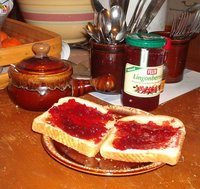Cowberry
|
|
| Cowberry Conservation status: Secure | ||||||||||||||
|---|---|---|---|---|---|---|---|---|---|---|---|---|---|---|
| Missing image Lingonberry.jpeg Cowberry | ||||||||||||||
| Scientific classification | ||||||||||||||
|
The Cowberry and Lingonberry (Vaccinium vitis-idaea L.) is a small evergreen shrub in the plant family Ericaceae that bears edible fruit. It is seldom cultivated but its fruits are commonly collected from the wild. Its native habitat is the circumboreal forests of northern Eurasia and North America, extending from temperate into subarctic climates.
There are two varieties of Vaccinium vitis-idaea:
- Vaccinium vitis-idaea var. vitis-idaea L. Cowberry. Eurasia. Leaves 10-25 mm long.
- Vaccinium vitis-idaea var. minus Lodd. Lingonberry. North America. Leaves 7-20 mm long.
Cowberry and Lingonberry shrubs are typically 10-40 cm in height and have a compact habit. They prefer some shade (as from a forest canopy) and constantly moist, acidic soil. Nutrient-poor soils are tolerated but not alkaline soils. They are extremely hardy, tolerating -40°C or lower, but grow poorly where the summers are hot.
Cowberries are only semi-woody, but keep their leaves all winter even in the coldest years, unusual for a broadleaf plant, though they are usually protected from severe cold by snow cover. The plants spread by underground rhizomes. They bear white flowers in the early summer. The fruits typically ripen in the autumn.
The Cowberry differs from the related and similar cranberries (Vaccinium oxycoccus, V. microcarpum and V. macrocarpon) in having white (not pink) flowers, with the petals partially enclosing the stamens and stigma (the petals are reflexed backwards in cranberries), and rounder, less pear-shaped berries. The fruit, actually a false berry, is red and tart. They resemble cranberries and the two fruits are often confused. Other related plants in the genus Vaccinium include blueberries, bilberries and huckleberries.
The Cowberry has also been called Lowbush Cranberry, European Cranberry, and Wild Cranberry. These alternate names perpetuate the longstanding confusion between the cranberry and the Cowberry and for this reason some botanists have suggested that they should be avoided.
Uses
Cowberry.jpg
Wild-collected cowberries are a popular fruit in northern Europe, notably in Scandinavia, where they are available for gathering on public lands. Because the berries are quite tart, they are almost always cooked and sweetened before eating in the form of jam, compote, juice, or syrup. Cowberry compote sometimes accompanies game meats.
Cowberries contain organic acids, vitamin C, provitamin A (as beta carotene), B vitamins (B1, B2, B3), and the elements potassium, calcium, magnesium, and phosphorus. Besides those healthful nutrients, cowberries also contain phytochemicals that are thought to counteract urinary-tract infections. Cowberries are used in herbal medicine.
See also
da:Tyttebær (Vaccinium vitis-idaea) de:Preiselbeere fr:airelle pl:Borówka brusznica ru:Брусника sv:Lingon

